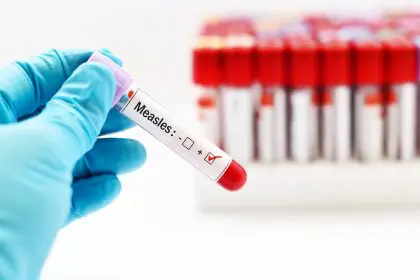A surge in measles cases has health officials on high alert as hundreds of Americans have been diagnosed with the once-rare disease. With exposure sites like a popular family resort making headlines, here’s what families need to know about the widening health concern.
The measles virus has reached epidemic proportions
The United States is facing a significant public health challenge as measles cases continue to multiply nationwide. So far this year, health authorities have documented 607 confirmed cases spread across 23 different states. More alarmingly, two children have lost their lives due to complications stemming from the infection.
The scale of the current outbreak marks a disturbing reversal of previous public health achievements. After measles was declared eliminated from the U.S. in 2000, sporadic outbreaks have occurred, but the current situation represents one of the most extensive spreads in recent decades.
“This is no longer just a localized concern,” a health department bulletin noted recently. The virus’s extraordinary contagiousness—it can remain airborne for up to two hours after an infected person has left a room—means that even brief exposure can lead to infection among those without immunity.
A Texas water park became an exposure hotspot
The Great Wolf Lodge in Grapevine, Texas, a beloved indoor water park and family resort, recently became the focal point of exposure concerns. A visitor who later tested positive for measles stayed at the lodge from March 28 to March 30, 2023, while infectious.
During their stay, the infected individual also visited the Grapevine Mills Mall, potentially exposing countless other visitors to the virus. The indoor nature of both locations creates particular concern, as enclosed spaces facilitate the airborne spread of the virus.
Health departments have issued notices asking anyone who visited either location during those dates to monitor themselves for symptoms and check their vaccination status immediately.
The resort situation highlights how quickly exposure can happen in family-friendly environments where many young children—some too young for vaccination—gather regularly.
The outbreak has touched nearly half of American states
What began as a cluster of cases in Texas has evolved into a nationwide concern. According to current tracking data, measles cases have been confirmed in 23 states: Alaska, California, Colorado, Florida, Georgia, Kansas, Kentucky, Maryland, Michigan, Minnesota, New Jersey, New Mexico, New York City, New York State, Ohio, Oklahoma, Pennsylvania, Rhode Island, Tennessee, Texas, Vermont, and Washington.
The geographic diversity of these cases demonstrates the virus’s ability to spread rapidly across state lines, particularly in an era of frequent travel. Urban centers with international airports have reported some of the highest numbers, reflecting the global nature of the current measles resurgence.
Health departments in affected areas have implemented enhanced surveillance measures and increased access to vaccination clinics in an effort to contain further spread. Some school districts in heavily affected regions have begun reviewing student vaccination records and sending home children without proper immunization documentation.
Recognizing symptoms can lead to faster treatment
Measles presents with a distinctive progression of symptoms that typically emerge 7 to 14 days after exposure. Initial symptoms resemble a common cold or flu, making early identification challenging.
The first signs include fever, which can reach high temperatures above 104°F, accompanied by persistent coughing, runny nose, and noticeably red, irritated eyes. These symptoms may last several days before the appearance of the characteristic rash.
The measles rash typically begins as flat red spots at the hairline before spreading downward to cover the face, neck, torso, arms, legs, and feet. As the rash progresses, the spots may join together and become raised. A person with measles remains contagious from four days before the rash appears until four days after it emerges.
For children, elderly individuals, and those with compromised immune systems, measles can lead to serious complications including pneumonia, encephalitis (brain inflammation), and in rare cases, death. Pregnant women who contract measles face an increased risk of miscarriage, premature birth, or having a baby with low birth weight.
Vaccination status determines your next steps after exposure
Health experts emphasize that response to potential measles exposure should be guided by vaccination status. For individuals fully vaccinated with both doses of the MMR (measles, mumps, and rubella) vaccine, the risk of developing the disease is minimal. The vaccine provides approximately 97% protection after two doses.
Those who haven’t received both vaccine doses face a different scenario. If exposure is recent—within 72 hours—receiving the MMR vaccine may provide some protection or reduce the severity of the disease if infection has already occurred. For exposures identified later, immune globulin injections can be administered within six days to help prevent or mitigate illness.
Parents of young infants face particular challenges, as the first dose of MMR isn’t recommended until 12-15 months of age. During outbreaks, health authorities sometimes recommend accelerating this schedule and giving the first dose to infants as young as six months when they live in or plan to travel to affected areas.
Health departments across affected states have established hotlines to help people determine their risk level and appropriate next steps. Many have also opened special vaccination clinics with extended hours to accommodate increased demand for immunization.
As the outbreak continues to evolve, public health experts stress the importance of herd immunity—when enough people in a community are vaccinated to protect those who cannot be immunized for medical reasons. With measles’ exceptional contagiousness, vaccination rates of approximately 95% are needed to prevent sustained community transmission.
For those uncertain about their vaccination status, blood tests can confirm immunity, and vaccination records can often be obtained from primary care providers, schools, or state health departments. There’s no harm in receiving additional MMR doses for those unsure of their status, making “better safe than sorry” a practical approach during the current outbreak.















